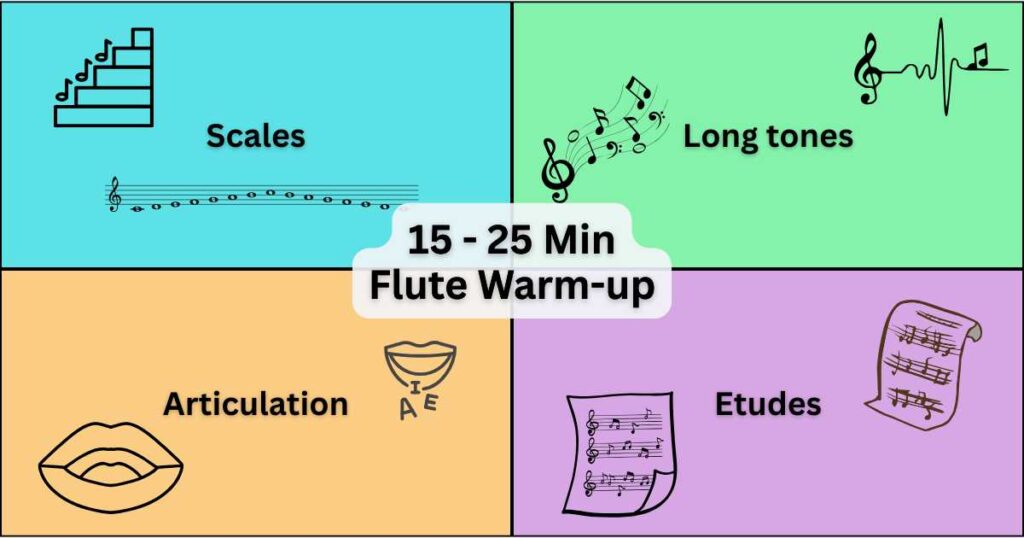Daily Flute Warm Ups: 7 Core Exercises To Start Strong With Free PDFs

Think of flute warm ups like “stretching before a workout” but for your flute skills.
When you pick up your flute, do the first thing — blow into a headjoint! Then, do a few notes, slowly, so your hands can catch up!
Flute warm ups aren’t just a routine. They’re your daily training. They wake up your body, align your brain, and get you ready to play your best.
What Are The Best Flute Warm Ups?
No two flute warm ups look exactly the same. What works for you today might not work tomorrow. Always have octaves and long tones.
Let’s break down the most common flute warm ups:
- Scales: finger memory, speed, and patterns
- Long tones: builds breath + tone (I call it my “zen mode”)
- Octave slurs: air control, flexibility
- Chromatics: finger flow and note connection
- Articulation drills: clean attacks, clarity (don’t skip these)
- Etudes / Mini melodies: musical feel (and just fun)

Before you even put the flute together, grab the headjoint. Blowing into just the headjoint lets you focus on your air speed, angle, and lip position. The goal is to get the fullest sound possible.
Once you’ve got that, then move to your assembled flute.
Hold your flute up with light, balanced hands. Don’t grip it too tight. You’re warming up both your tone and technique — so everything should feel steady, not stiff.
Every solid flute warm up starts with scales. They get your fingers moving and help you focus your breath.
Long tones are the heart of every warm-up. When your flute is cold, your intonation is all over the place…
…Long tones fix that! Start them in the middle register. From there, stretch to low notes.
Don’t forget articulation. You need to warm up your tongue, too. Try slurring and tonguing the same scales. Keep your tongue light and controlled, not choppy. Clean starts, clean stops.
After the slow scales and tone stuff, it’s time to turn up the heat and dive into etudes! The second half of a good flute warm-up should be technical work and studies.
All of this builds your flute strength and confidence. Over time, you’ll notice your flute warm ups bleed into better tone, smoother technique, and less tension.
Looking for a new flute? Check out my “13 Best Flute Brands – Ranked And Reviewed“!
1 Scales And Arpeggios
The first thing to play on your flute is a slow, slurred scale. Scales are the foundation of smooth playing. You gotta play them legato, slow and with care.
Play slowly at first. Set a metronome around 60 bpm — just a guide, not a rule. Focus on a clean tone, steady rhythm, and relaxed hands.
Play everything slurred first. Slurred means no breaks between notes — just one smooth stream of air. It helps to hear where your fingers mess up.
Begin with just one octave, in C major (A minor), or something that sits nice in the hand. When that’s clean, add the second octave.
After you get the hang of major scales, add minor and chromatic scales. Rotate them in to build ear training and finger control.
Download your “5 Flute Scales: Major, Minor, & Chromatic“!
Once your tone is warmed up and your hands are loose, your scales should go full range. Move through all the octaves your flute will give you. Push the range slowly, with control.
To make long tones interesting, mess with the dynamics! Start super quiet, swell to loud, then fade back out. Or reverse it.
Also, throw in chromatic scales. That way, you hit every single note and find out if anything’s sticking.
Arpeggios might look simple, but they really stretch your skills. You can’t fake a clean arpeggio. It shows everything. Start arpeggios in G major or F major. Keep the tempo the same — still slow, still focused. Every note needs to come out clear.
2 Flute Long Tone Warm Ups
The “Flute Long Tone Warm Up” includes long, sustained notes and “diminuendo” dynamics.
Start by playing a mf (mezzo forte) B natural in the middle register. It’s one of the easiest notes to play.
Find more flute long tone sheet music in my “Flute Long Tones: 3 Proven Exercises“!
Make it sound “rich,” “warm,” and “easygoing.” Don’t rush it — just hold the note and listen. Can you hear it vibrate in your chest or fingers? That’s a great sign!
If the sound feels tight or breathy, relax your lips again. Take another deep breath! We want the note to sound like it’s floating — not pushed or forced. Keep your fingers still and your body quiet.
At first, don’t stress about dynamics. Try “mezzo forte” to get your tone flowing. Later, explore the full range — from mf down to pp (“pianissimo”).
Long Tone Flute Warm Ups Breakdown:
- Key Signature: It changes throughout the exercise.
- Time Signature: 4/4 time (four beats per measure).
- Tempo: There’s no set tempo, but a slow, steady pace is best — around 60 bpm.
Keep the same “color” in your sound as you move from note to note.
Imagine you’re painting with sound — a smooth gradient from one shade to another. You don’t want big, splashy changes. Instead, each note should blend into the next, just like watercolors.
Keep your lip movement small — almost invisible!
Don’t shift your face or jaw too much when you change notes (even big ones, like C to F). The goal is: NO sudden jumps in sound, NO surprises. The tone stays calm and centered.
Repeat each group of notes twice. For the second time, fix any little things you notice.
Still not happy? It’s okay to try a third time — but only if you’re not tired. If you feel tired, pause. Rest is part of smart practice.
After each good tone, quickly breathe in and match that exact sound again. Each note should still feel full and colorful, even when soft. That’s the real magic trick — making “quiet” sound beautiful, not weak.
3 Flute Warm Ups: Articulation
Another thing to warm up is your tongue. Staccato, double-tongue, short bursts — go through the scales again, but this time tongue each note. No flute warm ups are complete without that.
Find more flute articulation exercises info in “5 Proven Flute Articulation Exercises Free PDF“!
Add articulation to the mix. Slurred playing is perfect for tone work. But don’t skip staccato. Those short, bouncy notes build speed and clarity.
Playing both slurred and tongued helps with music later.
Switching articulations also keeps your brain on. Slurred one day, staccato the next. It teaches you to adjust your air and tongue without losing tempo.
4 Flute Scale Warm Up
The “Flute Scale Warm-Up” moves through a familiar quarter notes scale pattern. If you’re still learning note names, fingerings, or rhythms — this warm up is perfect.
“Scale Flute Warm Up” get your fingers and brain “in sync” with your breath. It also trains your ear to hear scale steps!
This flute piece moves step-by-step through the B♭ major scale, covering two octaves. It starts on middle B♭ and climbs up and back down. Think of it as “climbing the stairs, one step per beat.”
Scale Flute Warm Ups Breakdown:
- Key Signature: B♭ Major (2 flats—B♭ and E♭)
- Time Signature: 4/4 (each measure has 4 beats)
- Tempo Marking: Dotted quarter note = 80 bpm (“slow and steady!”)
This is an etude-style warm-up — simple, classical, and instructional. It’s not performance music, but it builds performance skills. Since it’s a scale, harmony is implied rather than written. The exercise remains entirely diatonic with no modulations.
It has a clear notation — no slurs, no staccatos, no dynamics! Focus on the legato and clean fingering!
Start with mezzo forte (medium loud), then explore loud and soft playing once you’re confident. Focus on supportive breath and relaxed — pouty — lips.
Use “catch breaths” between lines. Don’t wait until you’re out of air. There are no rest signs, so take quick “sneaky” breaths at the end of each line.
5 Whole Step, Half Step: Smart Flute Warm Ups
“Whole Step, Half Step” is built on whole steps (2 semitones) and half steps (1 semitone). These tiny shifts help you to control and even tone.
It’s built to wake up your fingers and your brain.
If you want to improve your tone, tuning, and technique — all at once!! It has chromatic fingerings and keeps your fingers close to the keys!
Whole Step, Half Step Breakdown:
- Key Signature: C Major (no sharps or flats written)
- Time Signature: 4/4 (quarter note = 1 beat)
- Tempo Marking: No official tempo, but I recommend ♩ = 60–80 bpm
This piece is in C major, tho it moves through many chromatic sharps and flats.
You step up, then down. Again and again. This drill builds fluency across all keys. You don’t just stay in one key signature. You hit naturals, sharps, and flats in quick patterns.
Whole steps and half steps sound different. This lets you hear the difference clearly.
It ends with a longer chromatic passage — almost like a little challenge or “speed test”!
6 Flute Long Tone Exercise – Sonority 2
“Sonority 2” is the second part of a classic flute book called “Moyse’s Art of Sonority” or in full, “De la Sonorité: Art et Technique” by Marcel Moyse.
This is the most respected method books in the flute world. A legendary French flutist and teacher, Marcel Moyse, starts with long tones and slow intervals. He stretches the idea of practicing long tones across different keys.
Keep everything legato, soft, and slow — because the focus never leaves the tone. You’ll find the first exercise of the Sonority in “Flute Long Tones: 3 Proven Exercises“!
This exercise is not just for your fingers or embouchure. It grows your ability to communicate. Think of each note as a word or phrase you’re “speaking” with your flute.
Don’t treat Sonority like a drill. Treat it like a slow walk through sound. Each note is a choice. And each phrase is a chance to express.
Sonority 2 Breakdown:
- Time Signature: 4/4 (simple and steady)
- Tempo: Adagio or Largo is best (~60–72 bpm) — slow and peaceful
- Key Signatures: Multiple! It goes through several keys, including C major, B♭ major, F major, E major, and more
Moyse believed the flute is a melodic instrument (like singing). Don’t just blow air into the tube — shape every sound like a sentence, with a start, a peak, and a gentle end. Feel the emotion in EVERY breath!
Do not become “numb” to your sound. A fluties is the closest person to the tone — your ears are just inches from the flute — so you can easily stop listening carefully. This is why honesty is key! Become your own “quality control.”
Ask yourself often: “How does this note really sound?!”
And don’t fall into what Moyse calls “automatic pilot.” Every phrase must stay awake, alive, and intentional. Stay mentally engaged — the sound will grow!
Do not to lose the soft, delicate beauty of the flute’s natural voice. It’s easy to play loud. What’s hard is controlling a real, honest “piano.”
You should breathe like you’re about to swim underwater — big, full, and strong. Moyse suggests breathing in for two full beats before playing:
- The first breath sets you up.
- Every breath after that is just a “top-up”.
That way, you feel calmer and more in control. You’re not scrambling for air — you’re shaping phrases with confidence.
7 Technical Work and Etudes
The second half of your flute warm ups should be all about technique and full-range workouts.
Each day, pick just one short etude. Sight-read it once, then play it slowly a few more times. Watch for messy runs, bad tone, or stiff fingers. Loop just one line if it’s wrecking you.
One go-to book is 24 Etudes of Flutes, Op. 15 by Louis Moyse. Some of those etudes are sneaky hard, but they build flow. They’re written to challenge your technique while still sounding musical.
Another solid pick is Selected Studies — Rubank’s classic! You’ve probably seen this book—it’s in every band room ever. It’s got a mix of scales, arpeggios, and full-page etudes that push your endurance and clean playing.
Mix it up daily. (Don’t just do the same two etudes forever.) Rotate through pieces. One day focus on finger speed, the next on articulation or dynamics. This keeps your practice fresh and makes sure every part of your playing gets stronger.
And hey — don’t stress if it doesn’t sound perfect. This part of the warm-up isn’t about sounding pretty. It’s about building the engine behind your music. Pretty comes later. Keep showing up!
Flute Warm Ups Tips
Keep your lips soft and relaxed. They should never feel “tight” or “pinched”. Try saying “ooo” gently — that’s the feeling you’re aiming for. Sit tall or stand if you like — shoulders down, head up, spine long. This gives your lungs space to work.
Focus on your breath. Inhale deeply like you’re smelling soup (“mmm!”), and exhale slowly. That’s how you’ll keep a smooth, even tone. This breath should feel natural, not forced.
Use a metronome every time. You think your timing’s solid—then the click shows you what’s real.
Drop the tempo if the notes feel rushed or messy! It’s better to play slow and clean than fast and sloppy.
Conclusion: Top Flute Warm Ups
These 7 core flute warm ups are not just “optional extras” — they’re your daily fuel!!
Even five minutes a day is gold if you’re consistent. You don’t have to be perfect—just show up. Every. Single. Day.
Wanna sound cleaner? Faster? Fuller? It starts with warm-ups. Print the free PDFs. Stick them on your stand. Get that muscle memory goin’!






